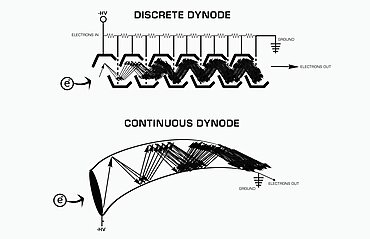
Back Multiplicador d'electrons Catalan چڕکەرەوەی ئەلێکتڕۆن CKB Sekundärelektronenvervielfacher German Multiplicador de electrones Spanish تکثیرگر الکترون Persian Électromultiplicateur French Elettromoltiplicatore Italian 電子増倍管 Japanese 전자증배관 Korean Elektronmultiplikator NN

An electron multiplier is a vacuum-tube structure that multiplies incident charges.[1] In a process called secondary emission, a single electron can, when bombarded on secondary-emissive material, induce emission of roughly 1 to 3 electrons. If an electric potential is applied between this metal plate and yet another, the emitted electrons will accelerate to the next metal plate and induce secondary emission of still more electrons. This can be repeated a number of times, resulting in a large shower of electrons all collected by a metal anode, all having been triggered by just one.
- ^ Allen, James S. (1947), "An Improved Electron Multiplier Particle Counter", Review of Scientific Instruments, 18 (10): 739–749, Bibcode:1947RScI...18..739A, doi:10.1063/1.1740838.